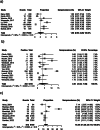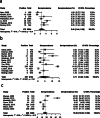The Prevalence and Genotype Distribution of Hepatitis C Virus in Kenya: A Systematic Review and Meta-Analysis
- PMID: 39254917
- PMCID: PMC11442939
- DOI: 10.1007/s44197-024-00299-1
The Prevalence and Genotype Distribution of Hepatitis C Virus in Kenya: A Systematic Review and Meta-Analysis
Abstract
Background: Hepatitis C (HCV) is a virus that causes chronic liver disease, end-stage cirrhosis, and liver cancer, yet most infected individuals remain undiagnosed or untreated. Kenya is a country located in Sub-Saharan Africa (SSA) where the prevalence of HCV remains high but with uncertain disease burden due to little population-based evidence of the epidemic. We aimed to highlight the HCV disease burden in Kenya with a summary of the available data.
Methods: The study was performed as per the Preferred Reporting Items for Systematic Review and Meta-analysis (PRISMA) guidelines. We searched publications reporting HCV prevalence and genotypes in Kenya between January 2000 to December 2022. The effect size, i.e., the HCV prevalence, was defined as the proportion of samples testing positive for HCV antibody. Study quality was assessed by the Joanna Briggs Institute (JBI) critical appraisal checklist. Due to high study heterogeneity, the studies were categorized into low-, intermediate-, and high-risk for HCV infection. The pooled estimate prevalence per category was determined by the random effects model. This review was registered in the International Prospective Register of Systematic Reviews (PROSPERO) (ID: CRD42023401892).
Results: A total of 29 studies with a sample size of 90,668 met our inclusion criteria, a third of which were from the capital city Nairobi (34.5%). Half of the studies included HIV-infected individuals (31%) or injection drug users (20.7%). HCV genotype 1 was the most common, with genotype 4 only slightly less common, and together they accounted for 94% of cases. The pooled prevalence for the low-, intermediate- and high-risk groups were 2.0%, 3.4%, and 15.5%, respectively. Over 80% of the studies had a score of > 6 on the JBI scale, indicating a low risk of bias in terms of study design, conduct and analysis.
Conclusion: Our findings demonstrate that there is a higher prevalence of HCV in key populations such as HIV-infected individuals and drug users than in the general population in Kenya. We found that HCV genotypes 1 and 4 were the most common genotypes. More data from the general population is required in order to establish baseline data on the prevalence and genotypes of HCV in Kenya.
Keywords: Genotypes; Hepatitis C virus; Kenya; Meta-analysis; Prevalence; Review.
© 2024. The Author(s).
Conflict of interest statement
The authors declare that the research was conducted in the absence of any commercial or financial relationships that could be construed as a potential conflict of interest.
Figures






References
-
- Global Hepatitis Programme. Accessed: Mar. 05, 2024. [Online]. Available: https://www.who.int/teams/global-hiv-hepatitis-and-stis-programmes/hepat...
-
- Global health sector strategy on viral hepatitis 2016–2021. Towards ending viral hepatitis. Accessed: Mar. 05, 2024. [Online]. Available: https://www.who.int/publications/i/item/WHO-HIV-2016.06
Publication types
MeSH terms
Grants and funding
LinkOut - more resources
Full Text Sources
Medical
Research Materials
Miscellaneous

